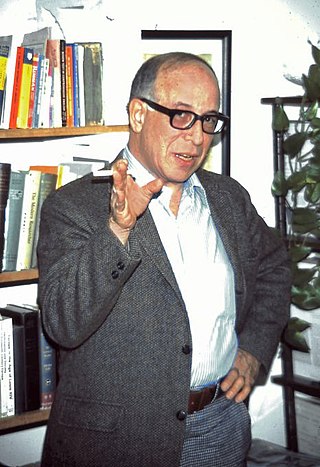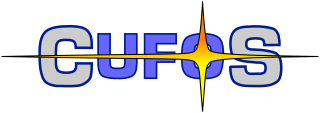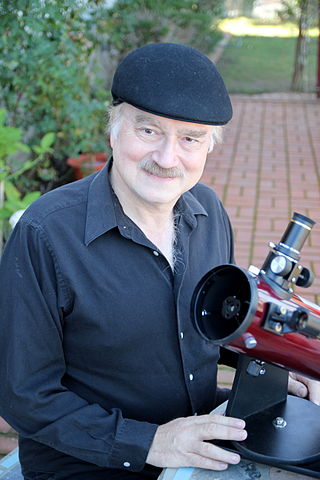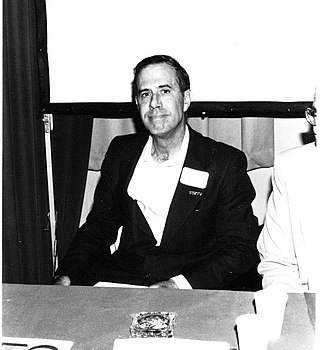
An unidentified flying object (UFO), or unidentified aerialphenomenon (UAP), is any perceived aerial phenomenon that cannot be immediately identified or explained. Upon investigation, most UFOs are identified as known objects or atmospheric phenomena, while a small number remain unexplained.
Majestic 12, also known as MJ-12 for short, is a purported organization that appears in UFO conspiracy theories. The organization is claimed to be the code name of an alleged secret committee of scientists, military leaders, and government officials, formed in 1947 by an executive order by U.S. President Harry S. Truman to facilitate recovery and investigation of alien spacecraft. The concept originated in a series of supposedly leaked secret government documents first circulated by ufologists in 1984. Upon examination, the Federal Bureau of Investigation (FBI) declared the documents to be "completely bogus", and many ufologists consider them to be an elaborate hoax. Majestic 12 remains popular among some UFO conspiracy theorists and the concept has appeared in popular culture including television, film and literature.

The Travis Walton UFO incident was an alleged alien abduction of American forestry worker Travis Walton by a UFO on November 5, 1975, while he was working in the Apache–Sitgreaves National Forests near Snowflake, Arizona. Walton was missing for five days and six hours. After days of searching with scent dogs and helicopters, Walton says he reappeared by the side of a road near Heber, Arizona. The Walton case received mainstream publicity and remains one of the best-known alien abduction stories, while scientific skeptics consider it a hoax.
The extraterrestrial hypothesis (ETH) proposes that some unidentified flying objects (UFOs) are best explained as being physical spacecraft occupied by extraterrestrial intelligence or non-human aliens, or non-occupied alien probes from other planets visiting Earth.
A debunker is a person or organization that exposes or discredits claims believed to be false, exaggerated, or pretentious. The term is often associated with skeptical investigation of controversial topics such as UFOs, claimed paranormal phenomena, cryptids, conspiracy theories, alternative medicine, religion, or exploratory or fringe areas of scientific or pseudoscientific research.

Josef Allen Hynek was an American astronomer, professor, and ufologist. He is perhaps best remembered for his UFO research. Hynek acted as scientific advisor to UFO studies undertaken by the U.S. Air Force under three projects: Project Sign (1947–1949), Project Grudge (1949–1951) and Project Blue Book (1952–1969).

The Cash–Landrum Incident was an unidentified flying object sighting in the United States in 1980, which witnesses claimed was responsible for causing health and property damage. Uncharacteristically for such UFO reports, this resulted in civil court proceedings, though the case ended in a dismissal.
Green fireballs are a type of unidentified flying object (UFO) that has been reported since the early 1950s. Early sightings primarily occurred in the southwestern United States, particularly in New Mexico. Although some ufologists and ufology organizations consider green fireballs to be of artificial extraterrestrial origin, mainstream, non-pseudoscientific explanations have been provided, including natural bolides.

Philip Julian Klass was an American journalist, and UFO researcher, known for his skepticism regarding UFOs. In the ufological and skeptical communities, Klass inspires polarized appraisals. He has been called the "Sherlock Holmes of UFOlogy". Klass demonstrated "the crusader's zeal for what seems 'right,' regardless of whether it brings popular acclaim," a trait he claimed his father instilled in him. "I've found," said Klass, "that roughly 97, 98 percent of the people who report seeing UFOs are fundamentally intelligent, honest people who have seen something—usually at night, in darkness—that is unfamiliar, that they cannot explain." The rest, he said, were frauds.

The Center for UFO Studies (CUFOS) is a privately funded UFO research group. The group was founded in 1973 by J. Allen Hynek, who at the time was chair of the Department of Astronomy at Northwestern University in Illinois.
Jerome Clark is an American writer, specializing in unidentified flying objects and other paranormal subjects. He has appeared on ABC News Special Report, Unsolved Mysteries, Sightings and the A&E Network discussing UFOs and other oddities. Clark is also a country and folk music songwriter of note.
The Lonnie Zamora incident was an alleged UFO sighting that occurred on April 24, 1964 near Socorro, New Mexico when Socorro police officer Lonnie Zamora claimed he saw two people beside a shiny object that later rose into the air accompanied by a roaring flame. Zamora's claims were subject to attention from news media, UFO investigators and UFO organizations, and the U.S. Air Force's Project Blue Book listed the case as "unknown". Conventional explanations of Zamora's claims include a lunar lander test by White Sands Missile Range and a hoax by New Mexico Tech students.
The Kelly–Hopkinsville encounter was a claimed close encounter with extraterrestrial beings in 1955 near the communities of Kelly and Hopkinsville in Christian County, Kentucky, United States. UFOlogists regard it as one of the most significant and well-documented cases in the history of UFO incidents, while skeptics say the reports were due to "the effects of excitement" and misidentification of natural phenomena such as meteors and owls. The United States Air Force classified the alleged incident as a hoax in the Project Blue Book files.

Robert Sheaffer is an American freelance writer and UFO skeptic. He is a paranormal investigator of unidentified flying objects, having researched many sightings and written critiques of the hypothesis that UFOs are alien spacecraft. In addition to UFOs, his writings cover topics such as Christianity, academic feminism, the scientific theory of evolution, and creationism. He is the author of six books.
Identifying unidentified flying objects (UFOs) is a difficult task due to the normally poor quality of the evidence provided by those who report sighting the unknown object. Observations and subsequent reporting are often made by those untrained in astronomy, atmospheric phenomena, aeronautics, physics, and perception. Nevertheless, most officially investigated UFO sightings, such as from the U.S. Air Force's Project Blue Book, have been identified as being due to honest misidentifications of natural phenomena, aircraft, or other prosaic explanations. In early U.S. Air Force attempts to explain UFO sightings, unexplained sightings routinely numbered over one in five reports. However, in early 1953, right after the CIA's Robertson Panel, percentages of unexplained sightings dropped precipitously, usually being only a few percent in any given year. When Project Blue Book closed down in 1970, only 6% of all cases were classified as being truly unidentified.

The 1976 Tehran UFO Incident was a radar and visual sighting of an unidentified flying object (UFO) over Tehran, the capital of Iran, during the early morning hours of 19 September 1976. During the incident, two Imperial Iranian Air Force F-4 Phantom II jet interceptors reported losing instrumentation and communications as they approached the object. These were restored upon withdrawal. One of the aircraft also reported a temporary weapons systems failure while the crew was preparing to open fire. An initial report of the incident was relayed to the U.S. Joint Chiefs of Staff on the day of the incident.
The Val Johnson Incident refers to an alleged encounter by Marshall County, Minnesota Deputy Sheriff Val Johnson with a UFO in 1979.

James Willett Moseley was an American observer, author, and commentator on the subject of unidentified flying objects (UFOs). Over his nearly sixty-year career, he exposed UFO hoaxes and engineered hoaxes of his own. He was best known as the publisher of the UFO newsletters Saucer News and its successor Saucer Smear, which became the longest continuously published UFO journal in the world.









